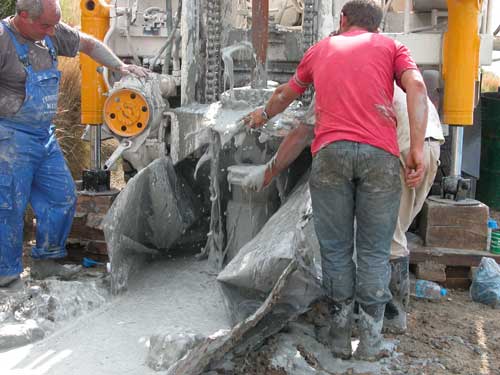Ithaca Found?

Drilling for Ithaca. © Robert Bittlestone.
Some tremendously exciting news was announced yesterday. Ithaca, the home of Odysseus from Homer's Odyssey, may have been located by Robert Bittlestone's project which was mentioned here last October. The reason why I'm finding it so exciting isn't so much that from what they've found, but from the way that different strands of evidence are coming together to confirm the idea.
Locating Ithaca has long been a puzzle, complicated by the fact that Homer may have been making some of the description up for dramatic effect. For instance he refers to wealthy Corinth, which was nowhere special at the time of Trojan Wars and didn't become a major power till much later. So there was the possibility that something similar was true of Ithaca.
Ithaca was described in the Odyssey:
I am Odysseus, Laertes' son, world-famed For stratagems: my name has reached the heavens. Bright Ithaca is my home: it has a mountain, Leaf-quivering Neriton, far visible. Around are many islands, close to each other, Doulichion and Same and wooded Zacynthos. Ithaca itself lies low, furthest to sea Towards dusk; the rest, apart, face dawn and sun.Odyssey 9, 19-26 (trans. James Diggle)
The island known in modern times as Ithaki is currently thought to be Ithaca, but there are problems. Ithaki is hilly, among other islands and slopes to the east. Paliki would be a much better fit for the description, but there's a problem there too. Paliki isn't an island, it's a peninsula on Kephalonia. Robert Bittlestone has looked at the isthmus connecting Paliki to the rest of the island and he's come up with a solution. He thinks the isthmus is infill of a marine channel and that, in ancient times, Paliki was an island. However the isthmus is up to 180 metres above sea-level. Is this reasonable?
There's evidence that it is. Strabo writing in the first few years AD, describes a channel which was periodically inundated. There's then the question how did this channel come to be filled? Kephalonia is a hotspot for earthquakes. The African tectonic plate is hitting into the European plate here, and so periodically there are major massive uplifts of land. These trigger landslides and rockfalls. Bittlestone thinks this is the process that filled in the channel.
Fortunately there is a way to test this idea. While the surface may look the same as the adjacent hills, the bedrock should, if Bittlestone is right, be noticeably different. On the other hills you don't have to go too far down to hit bedrock. So a drilling rig was set up over the proposed channel, and the results have just been announced (PDF). They drilled from a site around 107 metres above sea level down 122 metres, and they have not hit bedrock. This would appear to be infill.
The neat thing is that several lines of inquiry are coming together independently to the same result. The classical texts suggest there should be a channel, the geography favours Paliki over Ithaki as the site. On Paliki there is a site which looks like it could have Bronze Age architecture, to my non-specialist eyes. They're also finding Helladic pottery on site, which suggests Bronze Age occupation. Further there's another biological surprise which they weren't looking for.

© Robert Bittlestone
This is a fossil found in the drilling of the borehole. It's a microscopic marine nanofossil Emiliania huxleyi. It's the remains of plankton. Bizarrely it was found around 60 metres above sea-level and now there's a question how it got there. Bittlestone's team think it could have been placed there by splashing after a catastrophic landslide into the channel. Another alternative is that it landed in a tsunami event that moved up the channel. A project for 2007 is to try and decide what happened and how.
Further surveys by resitivity, ground penetrating radar and satellite survey are all also consistent with this being Ithaca. The most cheering aspect of all is the importance they're placing on the historical and archaeological context of the site. Even is this is a channel, it won't prove that Ithaca was on Paliki, but it would lend support to the idea. This year and next they still plan to use non-destructive methods to survey the site. The proof, if it happens, will come from more intensive excavation after 2009. It's only here I feel a bit negative because they plan to excavate Odysseus' Palace. The existence of King's Cross doesn't prove the existence of Harry Potter. The existence of a bronze age site on what might be Ithaca won't prove the existence of Odysseus, so I'm not sure if at the end of it they'll be able to say that Odysseus lived there.
Regardless, if the results continue to hold, it will be a fantastic discovery.
You can read more at www.odysseus-unbound.org
or watch a video clip from Channel 4 News.
Technorati Tags: ithaca, ithaki, odysseus, ancient+history, odyssey, homer, ancient+greece